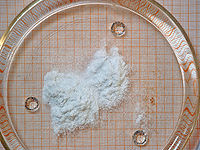Mercury(II) fulminate
 |
|
 |
|
 |
|
| Names | |
|---|---|
| Other names
Fulminated Mercury
|
|
| Identifiers | |
|
3D model (Jmol)
|
|
| ChEBI | |
| ChemSpider | |
| ECHA InfoCard | 100.010.053 |
|
PubChem CID
|
|
|
|
|
|
| Properties | |
| C2N2O2Hg | |
| Molar mass | 284.624 g/mol |
| Appearance | Grey, Pale Brown, or White Crystalline solid |
| Density | 4.42 g/cm3 |
| Melting point | 160 °C (320 °F; 433 K) |
| Boiling point | 356.6 °C (673.9 °F; 629.8 K) |
| slightly soluble | |
| Solubility | soluble in ethanol, ammonia |
| Explosive data | |
| Shock sensitivity | High |
| Friction sensitivity | High |
| Detonation velocity | 4250 m/s |
| Hazards | |
| Main hazards | Highly Toxic, Shock Sensitive Explosive |
| 170 °C (338 °F; 443 K) | |
|
Except where otherwise noted, data are given for materials in their standard state (at 25 °C [77 °F], 100 kPa).
|
|
|
|
|
| Infobox references | |
Mercury(II) fulminate, or Hg(CNO)2, is a primary explosive. It is highly sensitive to friction and shock and is mainly used as a trigger for other explosives in percussion caps and blasting caps. Mercury(II) cyanate, though its empirical formula is identical, has a different atomic arrangement; the cyanate and fulminate anions are isomers.
First used as a priming composition in small copper caps beginning in the 1820s, mercury fulminate quickly replaced flints as a means to ignite black powder charges in muzzle-loading firearms. Later, during the late 19th century and most of the 20th century, mercury fulminate or potassium chlorate became widely used in primers for self-contained rifle and pistol ammunition. Mercury fulminate has the distinct advantage over potassium chlorate of being non-corrosive, but it is known to weaken with time. Today, mercury fulminate has been replaced in primers by more efficient chemical substances. These are non-corrosive, less toxic and more stable over time; they include lead azide, lead styphnate and tetrazene derivatives. In addition, none of these compounds require mercury for manufacture, supplies of which can be unreliable in wartime.
Mercury(II) fulminate is prepared by dissolving mercury in nitric acid and adding ethanol to the solution. It was first prepared by Edward Charles Howard in 1800. The crystal structure of this compound was only determined in 2007.
...
Wikipedia

